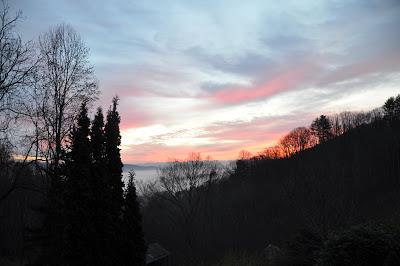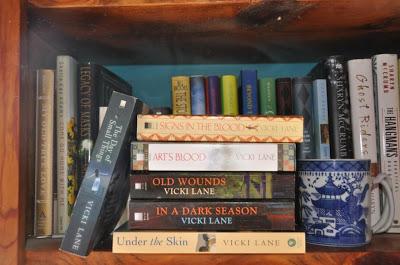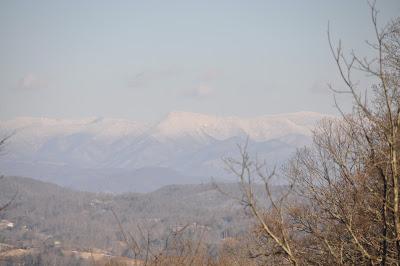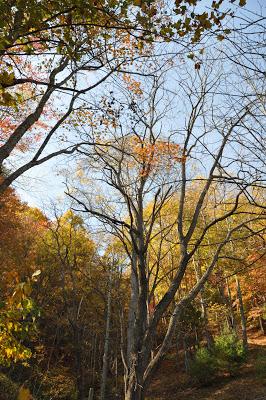
(continued from Sunday's post)
Fast forward to 2000. Our boys are away at college and with two fewer mouths to feed, we no longer keep a milk cow or raise pigs to butcher. I actually have some time on my hands and a friend and I sign up for a writing class at the Madison County branch of AB Tech –WRITING FICTION THAT SELLS – six classes for forty dollars. When we’re given the assignment of coming up with a main character and a setting for a novel, I am stymied – I’ve been out of what I think of as the Real World for so long that all I can imagine writing about is someone like me -- a middle aged woman. Living on a farm. In western NC. I decide it will be a mystery because I’d read a lot of mysteries and it seemed to me, in my innocence, that with a mystery the plot would take care of itself – all I needed was a murder victim and four or five potential killers. Thus began the Elizabeth Goodweather mysteries. And I proceeded to mine the experiences, observations, and stories I’d absorbed in the past 25 years.

It’s not just the people of my adopted home that I draw on for material – it’s the place itself – the flora and fauna of these ancient mountains. Many readers and critics have said that the setting of my books is almost another character. To me, the mountain landscape is a character with a story of its own. A story it will tell to anyone who’ll listen… When we moved to our mountain farm, we were immediately enchanted with the wild beauty on every side. Our building site looked east to nearby dark green mountains – tree covered for the most part with an occasional swath of paler green pasture. A single rusty-roofed barn in the middle of one of those pastures was the only building in our view. Row after row of green, almost as far as the eye could see. And beyond the green mountains, the Blue Ridge rising in hazy blues and violets.
 My romantic sensibilities loved
the thought of all that untouched forest out there and I said as much to the
old farmer from whom we were buying the land.
He looked at me kindly, as
one might look at a clueless but well-intentioned foreigner. “Back when I was a
boy, all that yonder was in fields and pastures
-- just some little patches of timber in the places too steep to plow."
As time went on, we became
increasingly aware of all those who’d inhabited the place we called our own –
arrowheads and spear points emerged from the field where we grew tobacco, as
well as a legs and arms of tiny china dolls and a rainbow variety of battered
marbles.
We learned that the
overgrown trails lacing the woods of our farm were the remnants of old logging
roads, and as we explored, we found, high on the mountain and in the midst of
the woods, a stone foundation. When we
asked our neighbor about this, he said that there had been a small tobacco barn
up there and went on to tell us of growing crops in a little hollow that was
now completely filled with trees. The
only clue that this hollow had once been cleared was the carefully stacked pile
of big rocks now almost invisible under poison ivy – rocks that had been
removed from the field to make plowing easier.
My romantic sensibilities loved
the thought of all that untouched forest out there and I said as much to the
old farmer from whom we were buying the land.
He looked at me kindly, as
one might look at a clueless but well-intentioned foreigner. “Back when I was a
boy, all that yonder was in fields and pastures
-- just some little patches of timber in the places too steep to plow."
As time went on, we became
increasingly aware of all those who’d inhabited the place we called our own –
arrowheads and spear points emerged from the field where we grew tobacco, as
well as a legs and arms of tiny china dolls and a rainbow variety of battered
marbles.
We learned that the
overgrown trails lacing the woods of our farm were the remnants of old logging
roads, and as we explored, we found, high on the mountain and in the midst of
the woods, a stone foundation. When we
asked our neighbor about this, he said that there had been a small tobacco barn
up there and went on to tell us of growing crops in a little hollow that was
now completely filled with trees. The
only clue that this hollow had once been cleared was the carefully stacked pile
of big rocks now almost invisible under poison ivy – rocks that had been
removed from the field to make plowing easier.
 Those rock piles dotted our
pastures, mute testimony to the hard working people who had cleared the land on
slopes where a tractor would be useless – but a team of sure-footed mules and a
turning plow could make a crop.
We were told that our cove had
once held five families and that the tiny log cabin near our house had been
home to family of six. We found the springs they had used and the few artifacts
they had left behind
I’m still learning to read
the land – to look for shadow roads -- what’s left of a wagon road running
alongside the paved road –and to follow creeks and branches till they disappear
under construction. The past is there –
as anyone who’s ever been misled by their GPS will tell you. Maps still mark
out dirt roads no longer traveled and GPS will lead you to them if it’s the
shorter way – no matter that these old roads are sometimes impassable or so
winding as to require a snail’s pace.
Once when we were pasturing
cattle on someone’s abandoned farm, I was utterly surprised to find a mile
marker set on the grassy track that ran in front of the old farmhouse – what
remained of a thoroughfare was now mostly swallowed up by woods.
Those rock piles dotted our
pastures, mute testimony to the hard working people who had cleared the land on
slopes where a tractor would be useless – but a team of sure-footed mules and a
turning plow could make a crop.
We were told that our cove had
once held five families and that the tiny log cabin near our house had been
home to family of six. We found the springs they had used and the few artifacts
they had left behind
I’m still learning to read
the land – to look for shadow roads -- what’s left of a wagon road running
alongside the paved road –and to follow creeks and branches till they disappear
under construction. The past is there –
as anyone who’s ever been misled by their GPS will tell you. Maps still mark
out dirt roads no longer traveled and GPS will lead you to them if it’s the
shorter way – no matter that these old roads are sometimes impassable or so
winding as to require a snail’s pace.
Once when we were pasturing
cattle on someone’s abandoned farm, I was utterly surprised to find a mile
marker set on the grassy track that ran in front of the old farmhouse – what
remained of a thoroughfare was now mostly swallowed up by woods.
 I always look for the remains of old
schools and water mills… and the tiny stores that once served the folks of the
remote coves and hollers – little wooden buildings, often with bars on the
windows, and situated on or near the roads – and I try to imagine a life
that didn’t depend on cars and trucks.
So in my books I share what I've discovered of what our county was like at various periods in history – and
each book has a secondary story set in the past – 1860, 1887, 1904, 1922, 1984.
Bit by bit I’m piecing
together the history of the little world I live in and letting it tell its
story through my imagination and in my books.
Though in the Elizabeth
Goodweather books I give my county another name – Marshall County instead of
Madison -- and people it with fictional characters, I try to stay true to the
land itself – the land and the lessons I’ve learned.
I always look for the remains of old
schools and water mills… and the tiny stores that once served the folks of the
remote coves and hollers – little wooden buildings, often with bars on the
windows, and situated on or near the roads – and I try to imagine a life
that didn’t depend on cars and trucks.
So in my books I share what I've discovered of what our county was like at various periods in history – and
each book has a secondary story set in the past – 1860, 1887, 1904, 1922, 1984.
Bit by bit I’m piecing
together the history of the little world I live in and letting it tell its
story through my imagination and in my books.
Though in the Elizabeth
Goodweather books I give my county another name – Marshall County instead of
Madison -- and people it with fictional characters, I try to stay true to the
land itself – the land and the lessons I’ve learned.
